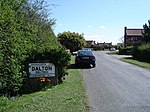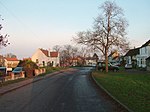Eryholme railway station
Eryholme railway station, originally named as Dalton Junction, was a railway station located on the East Coast Main Line between Northallerton and Darlington in North Yorkshire, England. It was the point at which the now closed Eryholme-Richmond branch line diverged from the East Coast Main Line. Passing the site today passengers on the East Coast main Line would be hard pressed to pinpoint the location of Eryholme, as all signs of the station have been demolished. The station probably saw its greatest number of passengers during World War II as it was the drop off point for servicemen arriving at the nearby RAF Croft. After the war it was also used by railwaymen living in nearby cottages for which trains stopped there but were not advertised in the timetables. This arrangement continued until 1969 when services on the Richmond Branch were withdrawn.
Excerpt from the Wikipedia article Eryholme railway station (License: CC BY-SA 3.0, Authors).Eryholme railway station
West Lane,
Geographical coordinates (GPS) Address Nearby Places Show on map
Geographical coordinates (GPS)
| Latitude | Longitude |
|---|---|
| N 54.449121 ° | E -1.534181 ° |
Address
Eryholme
West Lane
DL2 2PP , Dalton-on-Tees
England, United Kingdom
Open on Google Maps










